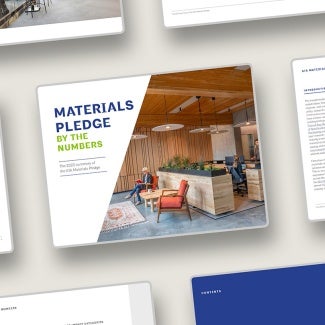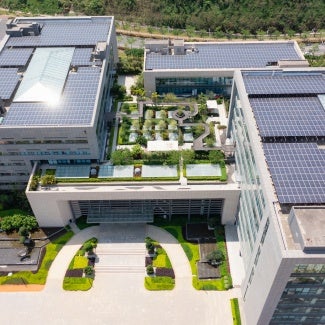COP29: AIA attends the 2024 U.N. Climate Change Conference
AIA is sending an official delegation to COP29 to raise awareness for the building sector, connect with decision-makers and partner organizations, and advocate for policies that support decarbonization and adaptation.

The 2024 United Nations Climate Change Conference
In 2015, the landmark Paris Agreement was adopted by 196 countries. This legally binding international treaty on climate change has spurred a worldwide effort to limit global warming to 2 degrees Celsius, and preferably below 1.5 degrees Celsius.
To effectively achieve this ambitious goal, we must promote a global exchange of expertise among all parties in the building sector, including national, state, and local governments; private industry participants, such as architects, commercial real estate developers, institutional building owners, engineers, building scientists, construction companies, and building product manufacturers; and nongovernmental civic leaders.
AIA stands ready to lead in the global effort to reduce and mitigate climate change. Our members, consisting of more than 98,000 architecture professionals, work at the leading edge of a $1.6 trillion U.S. construction industry1 that promotes commerce and drives consumer confidence. However, we are also stepping forward to address the needs of our planet and our communities. AIA seeks meaningful policies and is committed to a better (and more inclusive) built environment that will sustain a healthy world. In 2021, AIA was granted nongovernmental organization (NGO) observer status by the United Nations Framework Convention on Climate Change and sent six delegates to the 26th United Nations Climate Change Conference (COP26), an annual gathering of world leaders who are parties to the UNFCCC, in Glasgow, Scotland. Since then, AIA has sent a delegation to each COP as we work to emphasize the importance of the built environment in three critical areas.
External benefits & value
Humans spend 90% of our time indoors2 and our built environment has a major impact on our health and well-being. It is critical for architects and the construction industry to partner with other economic sectors and policymakers at all levels of government to demonstrate and communicate how we can provide long-term value through design best practices. We must be ready to counteract resistance to change, along with concerns over higher costs, by emphasizing improved financial returns and resilience for all those affected.
More research is needed to fully account for the detrimental impacts of outdated building industry practices. Some costs are currently not quantifiable within conventional real estate cost-benefit models that emphasize lowering “first” construction and development costs. In an industry that is called upon to build for conditions 50, 75, or 100 years into the future, we must also update our calculations of both costs and benefits. Still, the presence in the world’s ecosystem of pollutants, persistent bioaccumulative toxic substances, habitat loss, deforestation, ecosystem degradation, and threats to water quality and availability are all exacerbated by the extraction, production, and assembly of building components and materials.
Resources:
ROI of High-Performance Design
ROI: The economic case for resilient design
ROI: Designing for reduced embodied carbon
Framework for Design Excellence
Climate Action Business Playbook
Research & investment
The building industry technologies that will get us to decarbonize at scale and in time are within our reach. However, they are not yet widely available in the private commercial building industry. Zero-carbon steel and concrete, carbon capture and storage technologies, decentralized building-integrated renewable energy, and “smart” technologies that allow buildings to generate and distribute power are far from the mainstream. Many such technologies do not even exist yet. The world’s governments need to spur investment in research and development of these technologies to make them viable and available for both new construction and deep-energy retrofits of existing buildings.
Similarly, considerable research and development (R&D) investment needs to be made in improving existing specification, construction, and deconstruction processes due to the scale and complexity of the design and construction industries, the practical challenges of the transition to such as yet-to-be-realized technologies, the cumulative nature of carbon dioxide in the atmosphere, and the urgency of aggressive carbon reduction goals.
Architects need to actively help shape, support, and coordinate rigorous and meaningful international definitions of “net zero” as they apply to the design, construction, use, and deconstruction of buildings. Architects can support research, development, and specification to integrate breakthrough technologies into our design thinking and show the impact on our communities, businesses, and health.
Resources:
Energy use codes & performance standards
According to the 2023 Global Status Report for Buildings and Construction3, 40% of countries have mandatory or voluntary national regulations or codes for building energy performance.
With the highest demand for new building floor area being in developing countries where codes and enforcement mechanisms have yet to be introduced, global sharing of best practices for building codes, energy use performance standards, and enforcement mechanisms is necessary. Architects can demonstrate the value of codes to communities and advocate for the adoption of attainable standards in the U.S., where the adoption and implementation continue to be a struggle, as well as around the globe.
Resources:
Disruption, Evolution, and Change
AIA events at COP29
Thursday, November 14, 2:30pm
All In On Climate Resilience: Strategies and Partnerships for Impact co-hosted by FEMA and AIA
Baku, America Is All In Action Center
As climate threats grow, communities need innovative, collaborative approaches to build resilience at scale. This panel will feature leaders from federal and local government and the private sector to discuss adaptation strategies including nature-based solutions, equitable decision-making approaches, and cross-sector collaboration. Case studies will show how technical expertise, community leadership, and federal support can come together to drive tailored solutions.
Featuring: Kimberly N. Dowdell, AIA, NOMAC, 2024 President, The American Institute of Architects; Victoria Salinas, Senior Official Performing the Duties of Deputy Administrator for Resilience, U.S. Federal Emergency Management Agency; and Tim Keller, Mayor of Albuquerque.
Thursday, November 14, 12pm
Low Carbon Materials
AIA President Kimberly N. Dowdell, AIA, NOMAC, and RIBA President Muyiwa Oki
Baku, GCCA Pavilion (Pavilion E4)
Monday, November 18 - Thursday, November 21
AIA Exhibit, Exhibit Booth 40
Tuesday, November 19, 9:30am
Resilience, Heritage, and Just Transition in the Built Environment
Baku, Buildings and Cooling Pavilion (Pavilion G10)
Thursday, November 21, 11:30am
Buildings Breakthrough for Net Zero and Resilient Buildings: Solutions for Effective Transformation
Baku, COP29 Side Event Room 8
AIA's official UNFCCC side event in partnership with Royal Institute of British Architects (RIBA), Delta Electronics Foundation, and International Codes Council (ICC). Effective transformation is essential to achieve net zero and resilient buildings, but what do we need to do to implement this on a mass scale? This event will examine existing structures and how regulation, technology, design, and organizations are helping to deliver on this ambition.
References
- US Census Bureau. (n.d.). US Census Bureau Construction Spending Survey. United States Census Bureau. Retrieved August 29, 2022.
- U.S. Environmental Protection Agency. 1989. “Report to Congress on indoor air quality: Volume 2.” EPA/400/1-89/001C. Washington, D.C.
- Global Alliance for Buildings and Construction, International Energy Agency and the United Nations Environment Programme (2023): “2023 Global Status Report for Buildings and Construction: Towards a zero-emission, efficient and resilient buildings and construction sector.”



